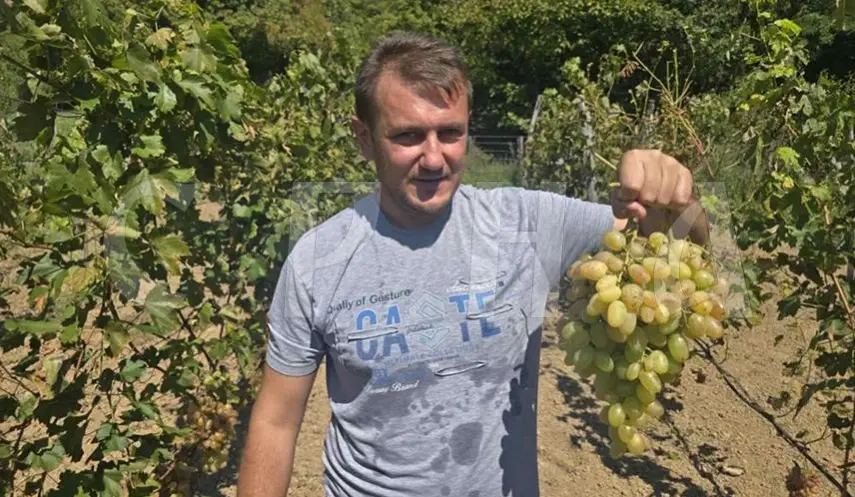GIANT GRAPES FROM RUSSIA ALSO GROW IN FOČA - VINEYARD WITH 106 VARIETIES OF GRAPEVINE
Republika Srpska - Foča - reportage
09/11/2025
12:30

FOČA, SEPTEMBER 11 /SRNA/ - On the right bank of the Ćehotina River, about seven kilometers upstream from Foča, lies a vineyard that is unusual and unique in many ways, planted with Russian and Ukrainian grape varieties, and it was established out of curiosity and as a hobby by Srebrenko Kunarac, a great enthusiast of viticulture.
On just around one quarter of an acre of land, a kind of experimental plot, this Foča native cultivates as many as 106 grapevine varieties from different regions, mostly from Russia and Ukraine, but also from Bulgaria, the USA, Moldova, and the Czech Republic. His goal is to find the most resilient and highest-quality varieties, to expand them, and to inspire more people to grow them.
These are, for this region, unusual grape varieties that cannot be found in stores, among which particular attention is drawn to those with giant clusters weighing more than two kilograms.
"Last year I weighed one cluster, which reached two kilograms and 700 grams. That was a young vine, and this year there are also many clusters exceeding two kilograms," Kunarac told SRNA.
In addition to varying sizes – from small grapes to extremely large ones that resemble plums, with or without seeds – there is also a wide spectrum of colors, shapes, aromas, and flavors. For example, the American variety Halloween, with its needle-shaped, hedgehog-like clusters, brings a truly exotic touch to this Foča vineyard.
Kunarac says it all began four years ago, when he wanted to spend as much time as possible outdoors after a hard day at work. He initially tried domestic varieties from producers in BiH and Serbia, but things didn't go quite as planned. The varieties were slow to establish and could not thrive without protective treatments, which he was determined not to use.
Then, he accidentally came across a Russian website about viticulture and was simply amazed by how vineyards look in Russia and Ukraine.
"I exchanged messages with those Russians and Ukrainians, asking them to send me cuttings and how to obtain them. It was a bit tricky until I found a Russian who sent me the cuttings. I paid him via PayPal and was overjoyed when they arrived, thinking I would have the same kind of grapes. However, the first year wasn't successful – I revived the cuttings, they started to grow, but I overwatered them, the roots rotted, and everything was lost," Kunarac recalls.
This initial setback didn't discourage him, so he continued searching and sourcing unusual grape varieties for the region from various places.
"Over time, I acclimated them, and now, in the fourth year, we've harvested our first substantial yield, which delighted everyone. We even got giant, beautiful grapes – I was amazed that something like this could grow in our area, grapes so beautiful that you simply can’t buy them in a store," says this unusual Foča vintner.
The biggest challenges, he notes, are the late spring frosts, which destroy the first crop. He also points out that the proximity of his plot to the Ćehotina River is a disadvantage, as the high humidity makes the vines susceptible to downy mildew.
"But I set myself a goal – I don’t want to treat the vines, and it's very difficult to find varieties resistant to the main diseases: downy mildew, powdery mildew, and gray rot. However, out of my 106 varieties, 10 to 15 have shown exceptional resilience and high yields over the past three years. So I now have about fifteen varieties acclimated to our area that can be propagated," Kunarac says.
He has also established a small nursery with the aim of spreading the successfully adapted varieties throughout the Foča municipality. He gladly gives seedlings to fellow citizens who are interested in growing grapevines.
"I would like it to spread, so that every household has a grapevine. It’s said that Foča used to be a vineyard region, and that grapevines thrived here until phylloxera appeared and wiped out the vineyards. But it can still thrive in our continental area, and I believe this could be the future, as the climate is changing and we now have a sufficient number of sunny days. The only drawbacks are late spring frosts and the high humidity in Foča, so it should be planted in a well-ventilated area with low moisture," Kunarac said.
Most of the varieties in his vineyard come from Novocherkassk in Russia, including Preobrazhenie, Viktor, and Jubilee of Novocherkassk.
"Then there are varieties such as Nizina, Alexa, and Livia – the queen of taste – followed by seedless varieties with a muscat aroma; no one remains indifferent after tasting them. People can hardly believe that the American Halloween is a grapevine: its needle-like berries can reach up to five centimeters, it is seedless, and very flavorful. Then there's Chameleon – a phenomenal variety – as well as Garmonia, Galahad, Baykonor, and Swings; all of these produce excellent results in our area," Kunarac says.
He emphasizes, however, that growing grapevines is a very demanding job."No one can maintain a vineyard if they don't love it. As the saying goes: `A vineyard requires a servant, not a master.` It demands constant work and attention, but that's no problem for me – I love it. I spend about an hour in the vineyard, working as much as I can, one row, then another; I simply enjoy it," Kunarac said.
He emphasized that he focused on ultra-early varieties with a short growing period of 90 to 100 days. In his vineyard, the grape harvest lasts from early August until late November and the first frosts.
"The vineyard is focused on table grape varieties, but I am also searching for wine grape varieties, which I am trying to acclimate. This isn't easy, as they require frequent treatments and more sunny days. I obtained about ten cuttings from Ukraine of a variety called Livadiyskiy Chornyi. In Ukraine, its sugar content reaches 28, while here it's 18, which is satisfactory for making a new Foča wine," Kunarac said.
He adds that he hasn't thought about selling the grapes, even though the yields are increasing; this year, he harvested more than two tons.
"These varieties yield about 30 kilograms per vine in their fifth year, and they are planted with a slightly larger spacing of three meters between vines, as they are vigorous and produce large crops. This year, in their third year, I certainly harvested more than 25 kilograms per vine. I designed this primarily as an experimental vineyard to acclimate varieties that I could later share. As for the assortment, of course, I will expand it; I am already searching for some exclusive varieties that are very difficult to obtain," Kunarac said.
The price of a cutting with three buds from Russia is around BAM 40 to 50.
"I paid that myself for certain varieties. When you say BAM 40 for a single ordinary branch with three buds, everyone thinks you're crazy. But this spring, I posted in a group that I was selling cuttings for BAM 3 each – I would have thrown away the leftover vines anyway – and in about 15 days, I earned over BAM 800 from it. But it's really worth it; let it cost BAM 40 if it's acclimated here and resistant," Kunarac explains, highlighting the realities of the planting material market.
He adds that he will remove varieties from his vineyard that haven't adapted well to local conditions or shown strong resistance, since his goal, he emphasizes once again, is to cultivate grapevines with as little chemical treatment as possible.
"Little or no protection at all, letting it grow organically – that's very difficult, but I hope I already have 15 to 20 varieties that can withstand it," he emphasizes.
He has already distributed numerous seedlings to friends and fellow citizens who want to grow grapevines.
"Even this year, there are people interested, and I will gladly help them. Let them have such beautiful varieties in their own gardens, even if just six or seven vines, including ultra-early, late, and mid-late varieties. It's something truly wonderful – a rhapsody of colors, flavors, and aromas, sheer perfection. Grapevines are a blessing: if you put in a little effort, they will reward you many times over with their beauty," Kunarac said.

FIRST HAGUE TRIBUNAL CONVICT DUŠKO TADIĆ PRESENTS BOOK, PLANS TO SEEK REVIEW OF VERDICT

CVIJANOVIĆ: GOOD NEWS ABOUT LIFTING OF SANCTIONS ON SRPSKA OFFICIALS

SANCTIONS AGAINST SRPSKA OFFICIALS LIFTED

ANĐELKOVIĆ: DODIK PROVES HE ENJOYS EASTERN POWERS’ TRUST


